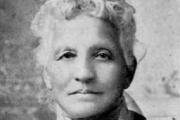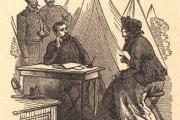The First Treasury Girls

Of all the Union government departments during the Civil War, the Treasury in particular was working overtime. In 1862, Congress passed the first Legal Tender Act, which gave the federal government the authority to issue currency. But with so many men off to war, who would make the money? No surprise, it turns out women can do that kind of thing, too.
Treasurer Frances E. Spinner took a note from the US Patent Office (which had a few female clerks) when he decided in 1862 to hire Jennie Douglas to trim money. Although we'd like to say she was a Washingtonian born and bred, Ms. Douglas was from New York — Spinner's home state. Bills at this time were printed four to a page and individual workers cut them out by hand. Spinner reasoned that women were naturally good with scissors, and only needed to be paid half as much to boot. Spinner was pleased with Douglas's first day, remarking that she “settled the matter in her behalf and in woman's favor.”[1]
With such success, Spinner set about hiring more women to trim and count money. With fast fingers and a head for numbers, a single clerk counted as many 50,000 bills in a day. Over the course of the war, over 400 women worked for the Treasury Department, including some who worked in Secretary Salmon P. Chase's office. They worked from 9 a.m. to 3 p.m. with 30 minutes for lunch. And they weren't the only “government girls” in Washington. Also in 1862, the War Department and the Quartermaster General's Office hired a number of female clerks and copyists. Through Spinner's example, it was understood that women would do the same work for much, much less pay.
In fact, the government girls made $600 per year, while men doing the same job made from $1,200 to $1,800 per year. In 1864, Congress actually passed a law stating that female federal clerks were not allowed to be paid more than $600.[2] By the end of the war, the ceiling had been raised to $720, but that's hardly an improvement. It wouldn't be until 1870 that Congress passed a law allowing women to be paid equal to men, but as can be imagined, few if any actually did provide equal pay.
Another downside to being a government girl was the public outcry about possible immoral behavior resulting from men and women working in the same office. One tax collector from Kalamazoo even went so far as to declare, “I do not think the service of females could be made efficient in the collecting department or be brought within the range of propriety.” The avoid impropriety, the administration established separate rooms and workspaces for female workers. In 1864, however, a minor scandal arose when an affair was alleged as having taken place in the Treasury. No less than a Congressional investigation proved these rumors to be false, however.
Women in government had their champions, however. The assessor of Manchester wrote, “female clerks are more attentive, diligent, and efficient than males and make better clerks. I intend very soon to have none but females in my office.” And Spinner, credited today with making the first federal push to hire women on a large scale, said his female workers were “hardworking, efficient, [and] had excellent work habits and integrity.”[3]
Many Treasury girls, like Douglas, were also from New York. Helen L. McLean Kimball, a Civil War widow was hired in 1863 and eventually rose to be chief of the Treasury Library. She was known for never missing a day of work and was celebrated in 1910, at age 90, for being the oldest women clerk employed by the government.[4]
Another, Mrs. Willard A. Leonard, was born in Pennsylvania; Like Mrs. Kimball, she decided to try for a Government position after her husband was killed in the Civil War. Hired in 1864, Leonard started out as a trimmer and later moved to the 'redemption division.' In this position, Leonard was responsible for sorting out counterfeit dollars from real ones. The stakes for a clerk in this position were high, should she mark a real as a fake bill, the amount of that bill would come out of her own pocket, whether $1 or $1,000. Leonard's skill was unmatched, however, and she ended her career as the chief counterfeit detector, known as the “female Sherlock Holmes.”[5]
By the 1870s, Treasury girls, and other government girls too, theoretically had equal pay and were generally well accepted. The women who worked in the Treasury had shifted from war widows to ladies “equal with or above angels” and “descended direct from Senators and Cabinet members of the old regime.”[6] The Treasury Department, and gradually other departments, hired more and more women as the 19th century waned, continuing into the 20th and 21st centuries. Female clerks are still waiting on that equal pay, though.
Footnotes
- ^ Munsch, Guy. “Women's History Month: Treasury spearheads hiring initiatives during the Civil War.” Treasury.gov. (2015)
- ^ Harper, Judith E. “Women During the Civil War: An Encyclopedia.” (Taylor & Francis, 2004).
- ^ “History.” Treasury.gov.
- ^ “Aged Woman Clerk Greeted by Friends.” Evening Star. (Washington, D.C.), 09 July 1910. Chronicling America: Historic American Newspapers. Lib. of Congress.
- ^ “I gave the best years of my life to my government.” The Washington Times. (Washington [D.C.]), 09 Aug. 1911. Chronicling America: Historic American Newspapers. Lib. of Congress.
- ^ “Gen. Butler's Attack upon the Treasury Girls.” Evening star. (Washington, D.C.), 25 March 1879. Chronicling America: Historic American Newspapers. Lib. of Congress.





